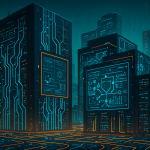The year is 2025. Flying cars, sadly, are still vaporware, but the AI revolution? It’s not just coming; it’s here. And if you want to know who’s holding the steering wheel, look no further than Nvidia. At their annual GTC conference, CEO Jensen Huang didn’t just drop a few bombs; he launched a full-scale, AI-powered armada. Think Oppenheimer, but instead of splitting the atom, they’re splitting the difference between reality and science fiction.
Huang’s keynote was less a product launch and more a declaration of intent: Nvidia isn’t just building chips; they’re building the future. A future where AI isn’t a buzzword but the very fabric of our digital lives. Forget Skynet; think… well, think a much more benevolent and incredibly efficient global brain, powered by Nvidia silicon.
The announcements came thick and fast, each one a potential game-changer. Let’s break down the highlights, shall we?
First up: Nvidia and Nokia are hooking up to build AI-native 6G. Yes, you read that right. 6G. While some of us are still struggling with spotty 5G coverage, these guys are already planning the next generation of connectivity, and it’s all going to be driven by AI. Imagine a network so intelligent it can predict bandwidth demands before they happen, optimize signal strength on the fly, and even troubleshoot itself. This isn’t just faster internet; it’s a smarter internet, one that anticipates our needs before we even know them. Think of it as the internet finally getting its doctorate in network engineering. The Aerial RAN Computer platform is the key here, acting as the AI engine that will power this next-gen telecom infrastructure. Forget buffering; prepare for seamless, instantaneous connection, everywhere, all the time. The implications for IoT, remote surgery, and even just streaming cat videos are enormous.
Then came the news that Uber and Nvidia are joining forces to unleash a fleet of robotaxis. Remember those promises of self-driving cars that were always “just around the corner”? Well, that corner might finally be in sight. Powered by Nvidia’s DRIVE Hyperion platform, these autonomous vehicles promise to revolutionize urban mobility. Imagine hailing a ride with your phone and a perfectly safe, AI-driven car arrives to whisk you away to your destination. No more awkward small talk with drivers, no more surge pricing during peak hours, just smooth, efficient, and affordable transportation. Of course, this raises some serious questions about the future of human drivers. Will they be retrained as robotaxi fleet managers? Will they find new roles in a world increasingly dominated by automation? Only time will tell, but one thing is clear: the ride-hailing landscape is about to get a whole lot more interesting.
But Nvidia isn’t just about software and services; they’re also doubling down on hardware. Announcing a partnership with Foxconn to build a robotic GPU manufacturing facility in Texas is a huge move. This isn’t just about increasing production capacity; it’s about creating a fully automated, AI-powered factory that can churn out GPUs faster and more efficiently than ever before. Think Terminator, but instead of building killer robots, they’re building the brains that power them. This facility is a testament to Nvidia’s commitment to vertical integration and their belief that the future of manufacturing is robotic. It’s also a strategic move to secure their supply chain and reduce their reliance on overseas production. Talk about bringing jobs back home, with a tech twist. And you can bet other chip manufacturers are watching closely.
And speaking of powerful hardware, Nvidia is also teaming up with the U.S. Department of Energy to build seven new AI supercomputers at national laboratories. These aren’t your average desktop PCs; these are behemoths of computational power, designed to tackle some of the most challenging scientific problems facing humanity. From climate modeling to drug discovery to nuclear fusion research, these supercomputers will be instrumental in pushing the boundaries of scientific knowledge. It’s a clear sign that the U.S. government is taking AI seriously and recognizes its potential to solve some of the world’s most pressing issues. This also hints at a potential AI arms race, with nations vying for supremacy in AI research and development. The implications for national security and global competitiveness are profound.
Finally, Huang unveiled the GB200 NVL72, a 72-GPU supercomputing rack that promises a tenfold improvement in performance and cost efficiency. This is the kind of hardware that makes AI dreams a reality. It’s like going from a horse-drawn carriage to a rocket ship. This unit is designed to handle the most demanding AI workloads, from training massive language models to running complex simulations. The NVL72 isn’t just about raw power; it’s about making that power accessible and affordable. This could democratize AI, allowing smaller companies and research institutions to compete with the tech giants.
Nvidia’s vision, as Huang articulated, is one of “Agentic AI” and “AI Factories.” It’s a world where digital twins and advanced robotics reshape industries, creating a more efficient, productive, and innovative future. Think Westworld, but instead of robot cowboys, you have robot factory workers building… well, everything. It’s a bold vision, and one that’s sure to spark debate and discussion. What does it mean for the future of work? What are the ethical implications of increasingly autonomous systems? These are questions we need to grapple with as we move towards an AI-powered future.
The financial implications are massive, of course. Nvidia’s stock price likely saw a nice bump, and the companies partnering with them are also poised to benefit. But the real economic impact will be felt across industries, as AI transforms everything from manufacturing to healthcare to finance. We’re talking trillions of dollars in potential economic growth, but also the risk of significant job displacement. It’s a high-stakes game, and Nvidia is playing to win.
So, what’s the takeaway? Nvidia’s GTC 2025 was more than just a tech conference; it was a glimpse into the future. A future where AI is woven into the fabric of our lives, transforming everything we do. Whether that future is utopian or dystopian remains to be seen, but one thing is certain: Nvidia is going to be a major player in shaping it. Buckle up, folks; the AI revolution has only just begun.
Discover more from Just Buzz
Subscribe to get the latest posts sent to your email.


